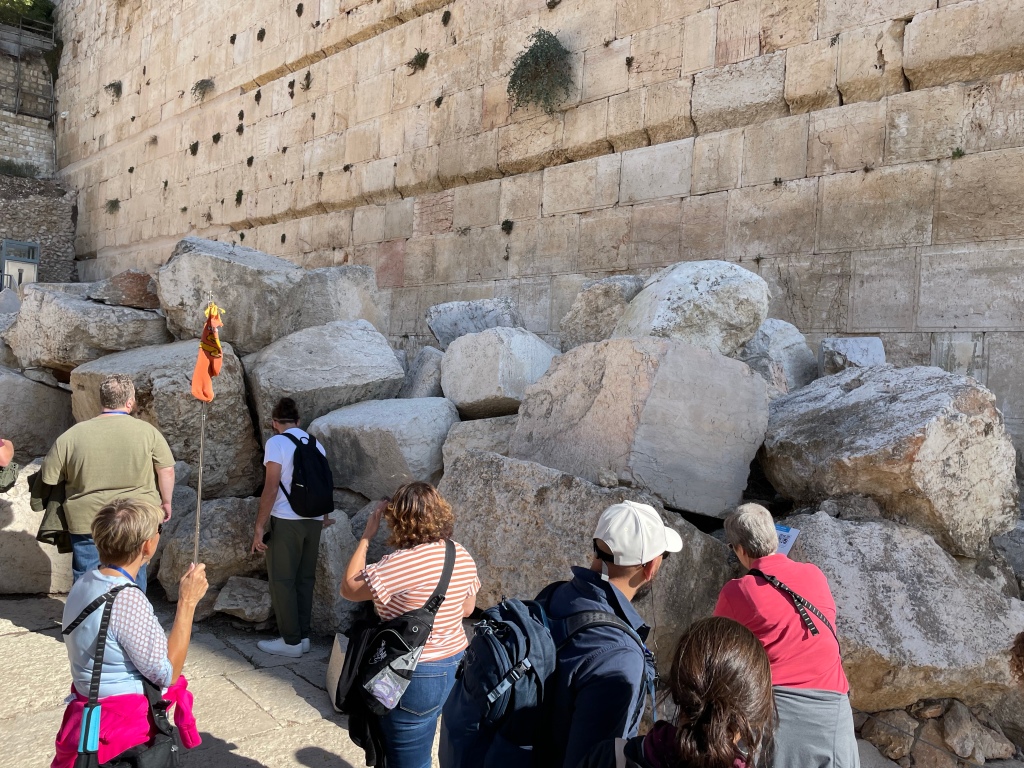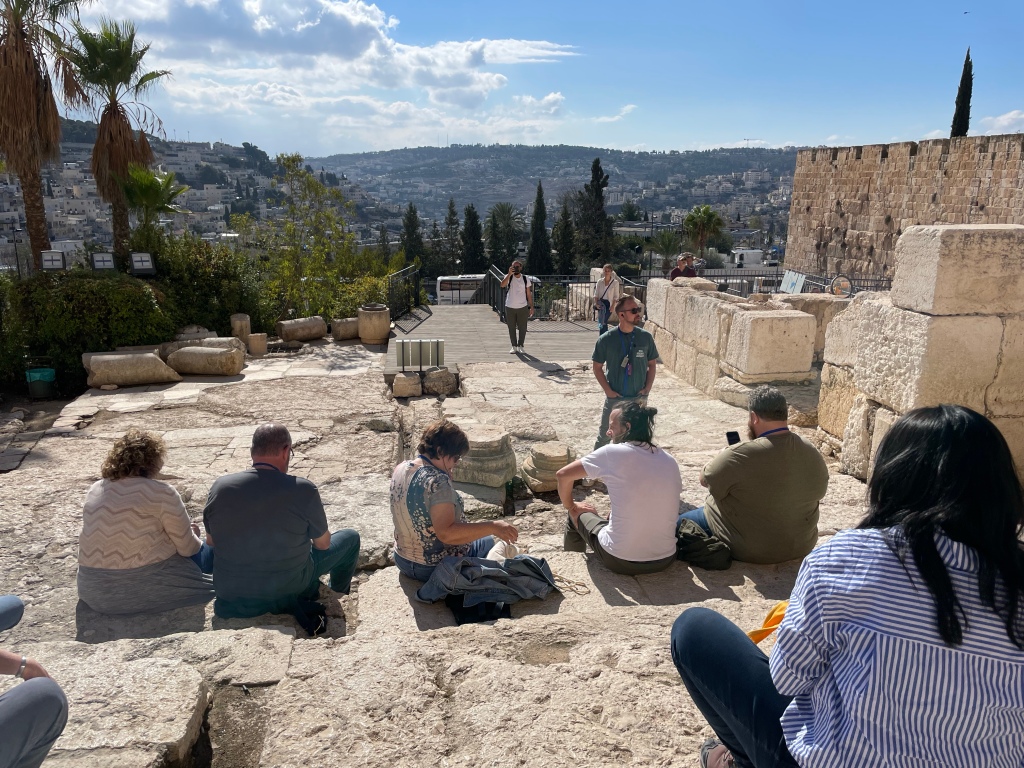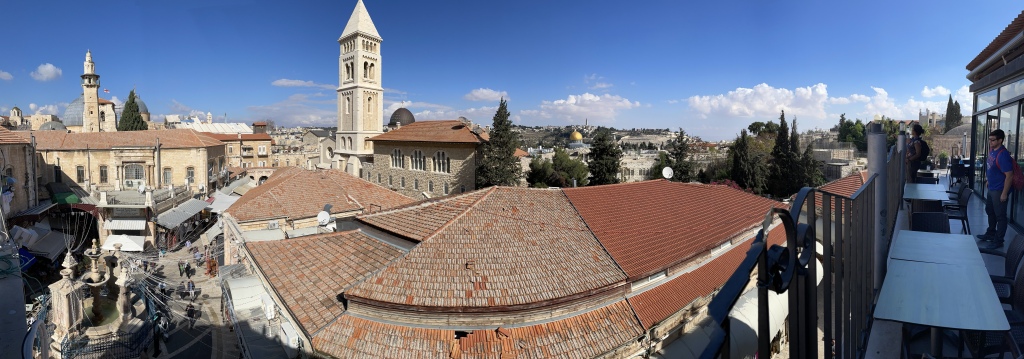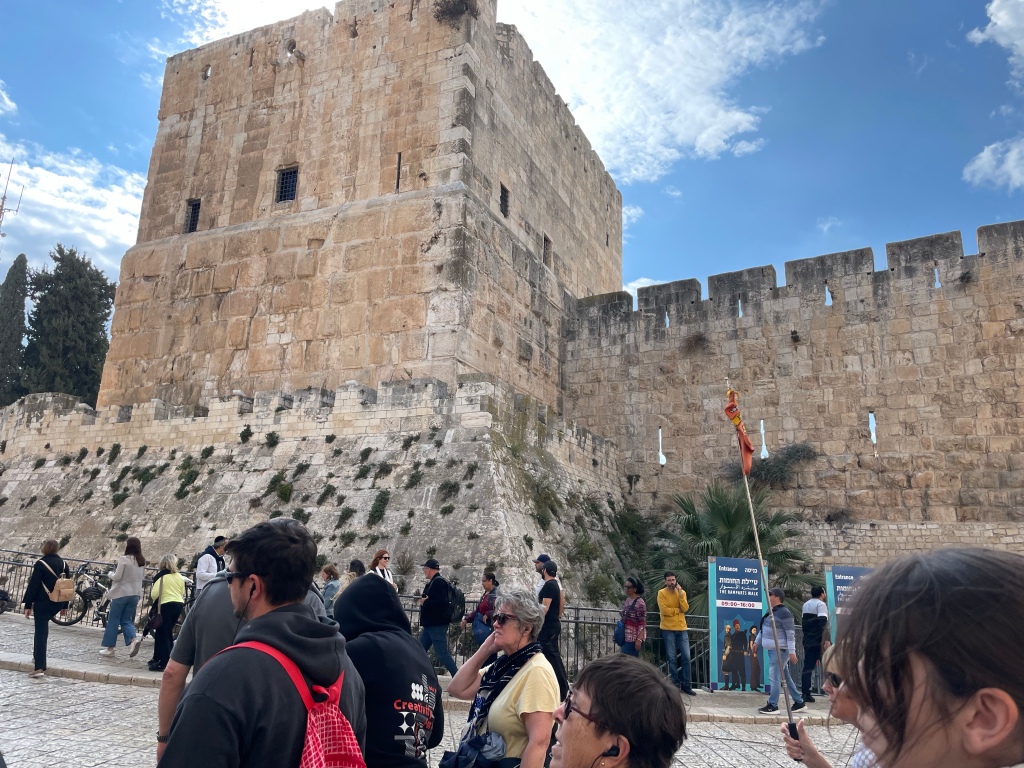Dearest Rachel –

We hear the bleat of a horn (and I’m not kidding – it drops a tone mid-honk) as we step off the bus this morning. It’s normal for the inhabitants, but it’s odd for us to land on an angle this steep. At least it’s easy to make our way out of the bus; just let gravity roll you toward the door.


One of the rules is that you’re not allowed to bring musical instruments (presumably for worship, which would offend the Muslim sensibilities) onto the temple mount. Daniel’s shofar does not pass muster, and is… well, not confiscated as such, as much as just held there at the security checkpoint for him to pick up once we’re done here. This isn’t the only thing that’s detained; no one’s allowed to bring Bibles onto the mound, either, and Yael is holding several of them even as we pass by her. She stores everything in a single locker, asking us to remember to remind her to pick them up when we’re done.







Even a panorama shot does not give an idea of the sheer size of the Temple Mount. It’s just that vast a space. The largest part of it was where the court of the Gentiles was, and when you think about it, there’s a lot of us goyim making our way around in here. Good thing the Lord suggested that they make room for us all.


Caliph Omar subsequently cleared the trash from the nearby Dung Gate in order to build a worthy mosque in honor of that event (as well as providing a substitute for hajj in a time where travel was that much more difficult and expensive, for it would-be pilgrims). Unlike the Dome of the Rock, which is built upon the peak of the mountain, and thus is the original building (despite being renovated in the sixteenth century with Armenian ceramic tile walls), the Al Aqsa mosque is the third such structure, as it has been destroyed by earthquakes twice in its history.
Speaking of history, Junior points out that the disciples were probably staying somewhere here in Pentecost, which is how the tongues of fire became public knowledge so quickly; it basically happened in public. He also mentioned that beneath the stones we’re walking on, archaeologist have discovered nearly 70 mikvahs, in which 3000 baptisms could’ve easily taken place in a single day.


This piece of news strikes me particularly hard; why should it be that, at one’s darkest hour, one should be forbidden from going before God? My loss – or anybody’s loss, for that matter, because it happens to all of us at some point in time – is not of our own doing; why should we be excluded from the fellowship because of it? And yet, apparently, we are reckoned as impure, and, should we wish to seek God in worship, we would be required to use the servants’ entrance to do so. Then again, I suppose we need to recognize that we all are servants, and have no right to stand before God, let alone walk into His presence.
Or maybe I’m overthinking things; when I ask her, Yael tells me that the official period of morning is only about a month.






The stairs are deliberately designed to be uneven, so you would need to look down (so you wouldn’t stumble on your way up), resulting in a humbled posture as you went up to the house of God.
Jordan speaks about the lame beggar who was healed, and how, even though he had to watch his steps, was practically dancing as he was praising God for the cure he’d just received. As the risk of a touch of blasphemy, I find myself thinking of the Sinfest comic strip, where a character yells at the sky, “God, you’re a crutch!”
“Well,” thunders the voice from above, “you’re lame.”
Lord, anything I have to say about this place seems so… lame in comparison.
***

So many years ago, on our first visit to the Wailing Wall, I could think of nothing to pray for that the Lord didn’t already know about. So I found myself praying for the peace of Jerusalem, as the psalms did. When you and I reunited shortly thereafter, you informed me that you had said a prayer for that theoretical girl that Daniel might someday marry. I was chagrined for not having thought of it.

There’s something about the practice that feels a lot like a Tanabata wish tied to a sacred tree during that holiday. There’s something almost superstitious about it, and it doesn’t set completely right with me. And yet, I feel the need to make the wish regardless.

Does it ever get cleared out at the end of the day? Does anyone ever see what the papers say, and pray over them, like the pastoral staff does with our prayer requests? Or are these simply thrown out every so often, in the hopes that God already knows what’s on them, and will answer them in His own time?
Yael tells us that the notes are collected twice a year, at Rosh Hashanah and Passover, and buried on the Mount of Olives – because it’s what one does with scripture. Had I known that, I would’ve taken a sashet of your ashes.
Maybe next time.






The menorah in the square is based upon the image from the arch of Titus in Rome, rather than what the original First Temple menorah might has looked like. The latter would have stood on a tripod, rather than an actual solid base





Anyway, we’re about to split up, and that’s a whole other topic for me to tell you about, honey. So until then, keep an eye on me, and wish me luck; I’m going to need it.
